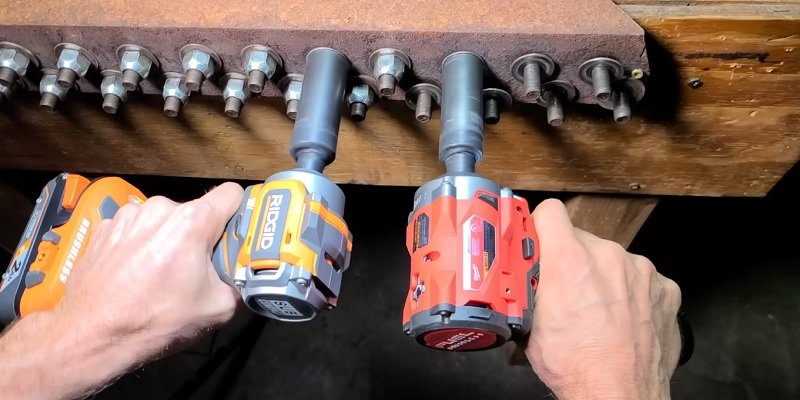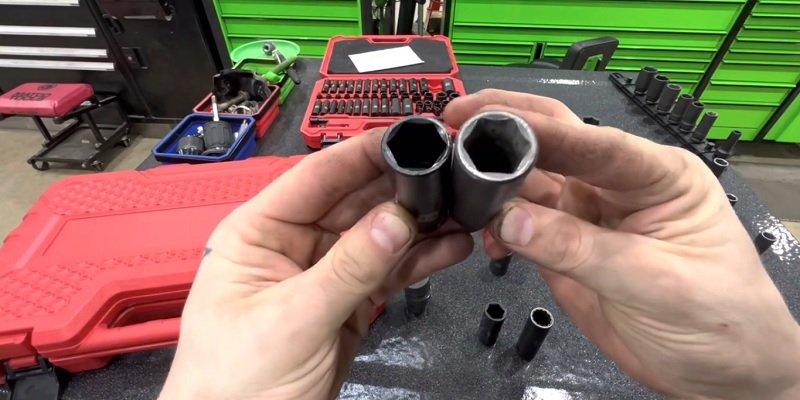Disclosure: This post contains affiliate links and I will be compensated if you make a purchase after clicking through my links. Learn More
To adjust the torque on an air impact wrench, locate the torque adjustment dial and turn it clockwise to increase torque or counterclockwise to decrease torque. The torque adjustment dial is typically found near the trigger or on the handle of the wrench.
Adjusting the torque allows for precise control and prevents over-tightening or under-tightening of fasteners.

Understanding The Importance Of Torque Precision
Impact Of Improper Torque On Fastener Integrity
Improper torque adjustment on an air impact wrench can have detrimental effects on fastener integrity. When the torque is too low, there is a risk of the fastener becoming loose or disengaged over time, leading to potential equipment malfunction or failure.
On the other hand, excessive torque can cause the fastener to become damaged or even snap, compromising its strength and compromising the overall integrity of the assembly. It is crucial to understand that accurate torque precision is the key to ensuring the longevity and reliability of the fasteners in any given application.
The Role Of Torque Accuracy In Achieving Optimal Performance
Achieving optimal performance requires precision in torque accuracy when using an air impact wrench. Each fastener is designed to withstand a specific amount of torque, and the equipment’s proper functioning depends on providing the right amount of force.
Too little torque can result in loose or unstable connections, impairing the equipment’s performance or even causing operational failure. Conversely, applying too much torque can lead to stress, strain, and potential damage to the fastener or the assembly as a whole.
Achieving the perfect balance between torque accuracy and the intended application ensures that the equipment functions flawlessly while maintaining safety and reliability.
Common Challenges Faced When Fine-tuning Torque
When it comes to fine-tuning torque on an air impact wrench, several challenges may arise. One of the common challenges faced is identifying the specific torque range required for a particular application.
Since different fasteners and components have varying torque specifications, it is crucial to identify the recommended range to prevent over or under tightening.
Another challenge is adjusting torque on fasteners located in hard-to-reach areas. It may require specialized tools or techniques to ensure precise torque adjustment without compromising safety or causing damage.
Additionally, factors such as operator error, tool calibration, or environmental conditions can also pose challenges in achieving accurate torque adjustments.
Overcoming these challenges is essential for maintaining the integrity and performance of the fasteners and the equipment they support.
Choosing The Right Tools For Torque Adjustment
When it comes to adjusting torque on an air impact wrench, choosing the right tools is crucial for achieving accurate and precise results. From evaluating air impact wrench specifications for torque control to exploring torque adjustment features and options available, the process requires attention to detail and knowledge of the best tools to use.
Evaluating Air Impact Wrench Specifications For Torque Control
Before diving into torque adjustment, it’s important to evaluate the specifications of your air impact wrench. These specifications determine the maximum torque that can be achieved and allow you to calibrate the tool accordingly. To ensure effective torque control, pay attention to the following specifications:
Rated torque: This is the maximum amount of torque the wrench is designed to deliver consistently.
No-load speed: This specification refers to the speed at which the wrench rotates when there is no resistance or torque applied.
Air consumption: Knowing the air consumption of your air impact wrench is essential for maintaining optimal performance while adjusting torque.
Reversible feature: Some wrenches come with a reversible feature, allowing you to switch between clockwise and counterclockwise rotation. This feature can be useful when adjusting torque in different directions.
Exploring Torque Adjustment Features And Options Available
Once you have evaluated the specifications of your air impact wrench, you can start exploring the torque adjustment features and options available. The level of precision and control you desire will determine the type of torque adjustment mechanism you need. Here are some common options:
Adjustable torque control: This feature allows you to set the desired torque level by adjusting a dial or knob on the wrench. It provides flexibility in achieving the required torque for different applications.
Multiple torque settings: Some air impact wrenches come with preset torque settings, allowing you to switch between different levels of torque without manually adjusting the tool.
Torque limiting devices: These devices are designed to prevent over-tightening by disengaging the impact mechanism when a pre-set torque level is reached. They offer an added layer of safety and control.
Recommended Torque Measurement Tools For Precision Tuning
For precise tuning and adjustment, it’s beneficial to have reliable torque measurement tools at your disposal. These tools help you monitor and confirm the accuracy of your torque adjustments. Here are some recommended torque measurement tools:
| Name | Description |
|---|---|
| Torque wrench tester | A device used to calibrate and verify the torque output of a wrench. |
| Torque screwdriver tester | Specifically designed to test and adjust torque settings on screwdrivers. |
| Torque gauge | An instrument used to measure the applied torque accurately. |
By utilizing these torque measurement tools, you can ensure that your air impact wrench is functioning within the desired torque range and make any necessary adjustments for precision tuning.
How to Adjust Torque on Air Impact Wrench-Step-by-step Process
Locate the Torque Adjustment Mechanism
The first step is locating the torque adjustment dial, knob, or buttons on your air impact wrench. This is typically present on the head or grip of the handle. Refer to the product manual for the exact location and operation of the torque adjustment mechanism on your model.
Set Up and Calibrate the Impact Wrench
Before adjusting torque, ensure that the air impact wrench is properly connected to the recommended air pressure supply. Inspect the tool and confirm proper operation by testing on a sample workpiece. If needed, calibrate as per manufacturer instructions so that the torque mechanism reflects true torque values.
Understand the Adjustment Directions
Most air impact wrenches allow you to increase or decrease torque by rotating the mechanism clockwise or anticlockwise respectively. However, some models may differ, so verify the directions by referring to the product literature or on-tool markings.
Start with Minimum Torque
Initially, set the adjustment mechanism to the minimum torque setting. Gradually increase in small increments, testing in-between on a suitable workpiece, until desired torque is reached. Avoid starting at higher values as it increases risks of overtightening.
Test and Verify the Torque
Use a reliable torque wrench to validate the torque output from the air impact after adjustment. Tighten test fasteners using the preset impact torque and confirm the actual torque applied with the torque wrench. Fine-tune further if needed.
Recheck Periodically
It is highly recommended to check torque accuracy and repeat the adjustment steps periodically on your impact wrench to prevent performance issues over time. Impacts from regular use can cause deviations from presets.
Troubleshooting And Problem-solving
When it comes to using an air impact wrench, adjusting torque is a crucial step to ensure optimal performance. However, like any tool, you may encounter some issues along the way. This section will focus on troubleshooting and problem-solving techniques to help you navigate common challenges when adjusting torque on your air impact wrench.
Identifying Common Issues With Torque Adjustment
Before diving into the troubleshooting process, it’s important to be able to identify common issues that may arise when adjusting torque on your air impact wrench:
- Inconsistent torque readings
- Difficulty in fine-tuning the torque
- Unreliable torque setting retention
Understanding these common issues will allow you to address them effectively, ensuring smooth and accurate torque adjustment for your wrench.
Addressing Inconsistencies In Torque Readings
One of the most frustrating challenges during torque adjustment is encountering inconsistent torque readings. This can lead to unreliable tightening or loosening of fasteners. To address this issue, follow these steps:
Check for any loose connections: Start by ensuring that all connections and fittings are securely tightened. Loose connections can lead to air leaks, impacting the accuracy of torque readings.
Inspect the torque reaction mechanism: The torque reaction mechanism plays a critical role in delivering accurate torque readings. Check for any signs of damage or wear and replace if necessary.
Verify the air pressure: Inconsistent air pressure can lead to inconsistent torque output. Use a reliable pressure gauge to confirm that the air pressure supplied to the wrench matches the recommended specifications.
By addressing these potential causes, you can minimize inconsistencies in torque readings, resulting in more reliable and precise adjustments.
Tips For Overcoming Challenges During The Fine-tuning Process
Fine-tuning the torque on your air impact wrench can pose its own set of challenges. To ensure a smooth and successful process, consider the following tips:
Start with a low torque setting: Begin by setting the torque to the lowest level and gradually increase it until the desired torque is achieved. This allows for fine adjustments and minimizes the risk of overtightening.
Use a torque calibration tool: Investing in a torque calibration tool can greatly simplify the fine-tuning process. This tool provides accurate torque readings and helps you verify the calibration of your wrench.
Regularly clean and lubricate the tool: Accumulated dirt and debris can impact the performance of your air impact wrench. Regularly clean and lubricate the tool to ensure smooth operation during torque adjustment.
Implementing these tips will help you overcome challenges encountered during the fine-tuning process, making it easier to achieve accurate and consistent torque adjustments.
Frequently Asked Questions On How To Adjust Torque On Air Impact Wrench?
How Do You Set A Pneumatic Torque Wrench?
To set a pneumatic torque wrench:
- 1. Check the recommended torque range for your application.
- 2. Adjust the wrench’s air pressure according to the manufacturer’s instructions.
- 3. Select the desired torque setting on the wrench.
- 4. Attach the appropriate socket or bit to the wrench.
- 5. Apply the wrench to the fastener and stop when the desired torque is reached.
How Do You Adjust The Torque On Cordless Torque Wrench?
To adjust the torque on a cordless torque wrench, locate the torque adjustment collar and twist it to the desired setting. Make sure to follow the manufacturer’s instructions for accurate adjustment.
How Do You Prevent Over Torque With Impact Wrench?
To prevent over torque with an impact wrench:
- 1. Use a torque wrench to accurately measure the desired torque level.
- 2. Adjust the impact wrench to the appropriate torque setting before use.
- 3. Avoid using excessive force or applying additional pressure while operating the wrench.
- 4. Regularly calibrate and maintain the impact wrench to ensure accuracy.
- 5. Follow the manufacturer’s instructions and recommended torque specifications for the specific application.
Final Thoughts
Adjusting the torque on an air impact wrench is a crucial skill for any mechanic or DIY enthusiast. By following the simple steps outlined in this guide, you can ensure the proper and precise application of torque for various tasks.
Remember to always consult your wrench’s user manual for specific instructions and guidelines. With a little practice and patience, you’ll be able to wield your air impact wrench with confidence, improving the efficiency and effectiveness of your work.


